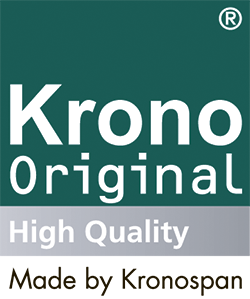Installation Guide
Laying laminate floors
Tips for laying laminate
Laying laminate floors is child's play. But it is important to prepare all the materials and work stages well. Below, you will find step-by-step instructions for laying laminate, and a check-list to make your preparations easy.
Generally, you have three options for laying a laminate floor:
1. Glueless, quick laying
2. Laying using Clickguard or a similar joint sealant. This permanently protects the floor against the effects of moisture from above. Despite this, the floor can be taken up again and re-laid.
3. Laying using glue similarly provides permanent protection against moisture, but the work is more involved and it is no longer possible to dismantle the floor for possible relaying. First, you need to establish the substrate onto which you want to lay your laminate floor. That's because not every laminate floor is suitable for every substrate!
Laying laminate onto a screed
The floor must be absolutely level, dry, clean and capable of bearing loads. Unevennesses of more than three millimetres over a metre must be levelled and filled. A PE film must be used as a moisture barrier.
Laying laminate onto wooden floorboards
You need to attach loose floorboards and level any uneven areas – you need to create a solid and level substrate. Lay the laminate floor at right-angles to the run of the wooden floorboards. With wooden floorboards, you must not use a PE film.
Laying laminate onto chipboard panels
Loose chipboard panels must be attached and uneven areas levelled. The chipboard panels must be firmly affixed to the sub-floor to avoid any grating noises developing.
Laying laminate onto PVC or linoleum flooring
You should not lay laminate floors onto these types of flooring. These types of floor covering must be removed without fail before laying laminate.
Laying laminate floors into hot water and modern electrical underfloor heating
Please consult a trusted heating specialist regarding heating your floor until dry. He or she has the relevant skills and the necessary protocols.
A surface temperature of 25 degrees Celsius is recommended; you should not exceed 28 degrees Celsius under any circumstances. You must remove old floor coverings.
Preparation & materials check-list
Before laying laminate
1. Please store the packs for 48 hours under the same climatic conditions as will be experienced during laying.
2. A room climate with around 20 degrees Celsius and a relative air humidity of 50 to 70 per cent is a key precondition for installing and maintaining the value of the laminate floor for the long term.
3. The underfloor must be absolutely level, dry, clean and capable of bearing loads.
4. When laying the floor onto a mineral substrate such as concrete, cement screed, anhydrite screed or stone tiles, you must first measure the moisture level. The screed should not exceed the following values for residual moisture in any instance:
1. Cement screed: with underfloor heating 1.8% concrete moisture (CM); without underfloor heating 2% CM.
2. Anhydrite screed: with underfloor heating 0.3% CM; without underfloor heating 0.5% CM.
5. Before laying on mineral underfloors, a suitable damp-proof membrane (PE film) must be installed as a trough to protect against moisture. Allow the runs to overlap by 20 cm and fasten using adhesive tape.
6. A carpet is not a suitable underlay, and any remaining carpet must be removed completely prior to laying. A laminate floor is laid as a floating floor, and must not be attached to the underfloor.
7. For floors without footfall sound insulation, please use a 2 mm PE foamed film or other suitable underlay for footfall sound insulation.
8. Lay the runs in the same orientation as the flooring panels.
9. Lay opened packs immediately.
You should keep the following tools to hand at all times when laying your laminate floor:
• Spacer wedges
• Circular saw with changeable carbide metal tooth saw blade, jigsaw with fine saw blade or handsaw
• Angle for undercutting the door-frames
• Folding ruler, pencil
• Assembly tools
• Footfall sound underlay (for floors with no footfall sound insulation)
• Checklist of materials & accessories for laying laminate floors
• Accurate measurements of the room size
• Laminate floor
• Clickguard / one tube is sufficient for ten square metres of laminate floor
• Skirting boards
• Levelling, transition and end profiles
• Mounting brackets
• Damp-proof membrane
• Footfall sound insulation
Please also note that under certain circumstances footfall sound insulation and Clickguard or a comparable joint sealant may be required.
Residual moisture
The screed should not exceed the following values for residual moisture in any instance:
Cement screed: with underfloor heating 1.8% CM; without underfloor heating 2% CM.
Anhydrite screed: with underfloor heating 0.3% CM; without underfloor heating 0.5% CM.
Joint system installation guides
1clic 2go pure Vinyl Installation Guide
Fold Down Installation Guide
Angle / Angle Installation Guide
Quattro Clic Installation Guide
1clic 2go pure Laminate Installation Guide
Top Clic Installation Guide
Kronowall 3D Installation Guide





























 080755744
080755744
 service@krono-shop.com
service@krono-shop.com


















